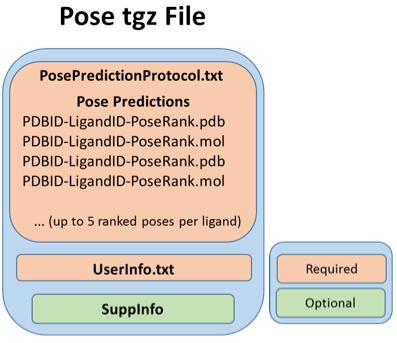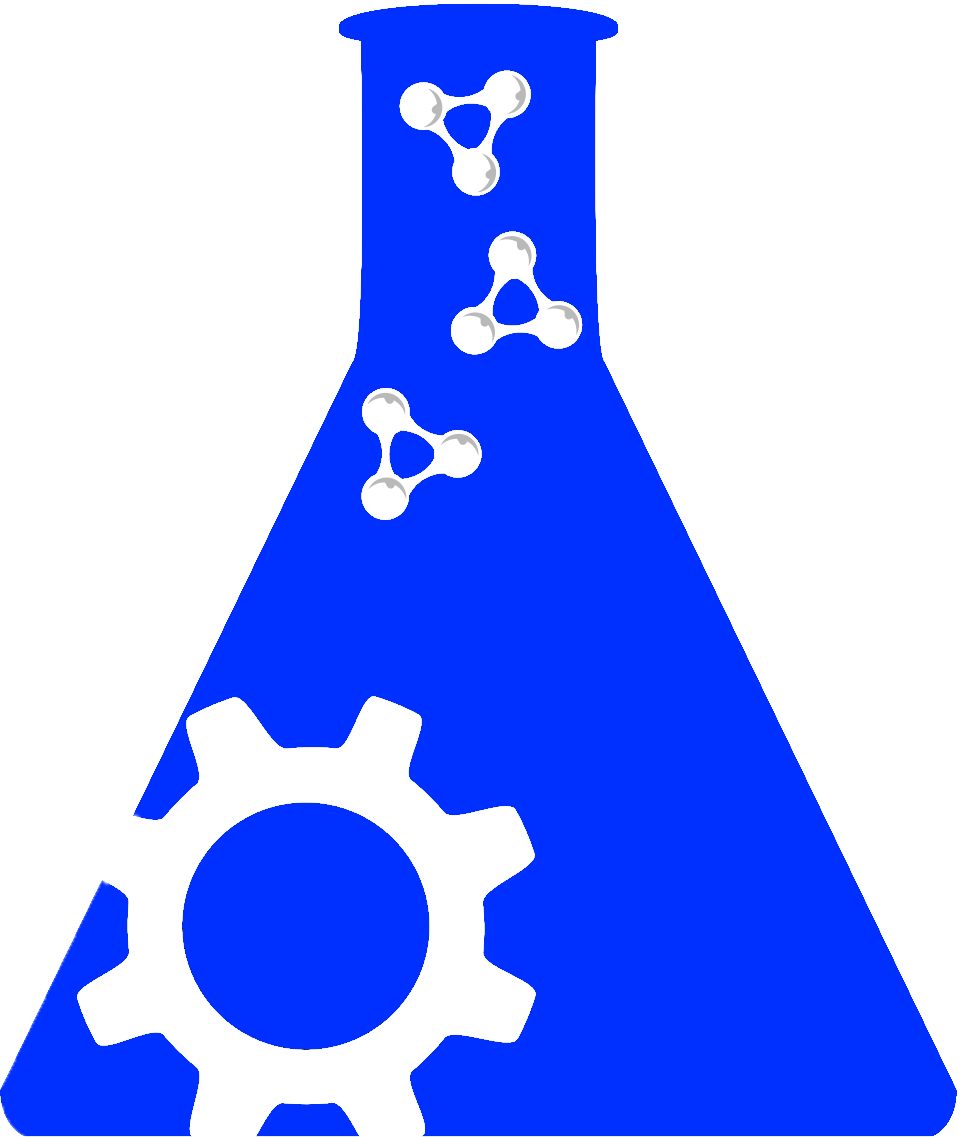Leaving Community
Are you sure you want to leave this community? Leaving the community will revoke any permissions you have been granted in this community.
Overview
The procedures for Stage 1b are identical to the Stage 1 pose prediction sub challenge, except that the filenames should reflect that each ligand must be docked into its corresponding "self-docking" PDB file.
For Stage 1b, you can submit predictions for protein-ligand poses. Each prediction must be submitted in the form of a gzipped tar (.tgz) file. The D3R website will provide separate upload options for files of the following type:
- A Pose tgz file, containing pose predictions and associated information.

Figure 1. Required contents of the Pose tgz files for Grand Challenge 3.
Content and Generation of TGZ files
The following section details the required contents and format of these files. Additionally, blank template files for this challenge are available for download, as are examples of completed gc3_cats_pose.tgz. Note that the example files contain artificial information, and thus serve only to illustrate the required contents and formats of a submission.
template files || pose example files ||
Submissions that do not adhere to these requirements should be rejected by our submission system; we recommend that you leave time before the deadline to correct any technical errors that result during the submission process. If a file with technical errors does pass the automated validation step, we will do our best to interpret the submission and may contact you for help with this. However, if a file proves particularly problematic, it may be necessary to omit the submission from evaluation.
The information required for each type of tgz file is summarized in Figure 1 and detailed in the following subsections. Note that every tgz type requires a user information file (UserInfo.txt). Because this file is common to all tgz types, it is not addressed in the descriptions of each tgz type, but is instead detailed separately (see The User Information File, below), as is the general procedure for generating the tar files (see How to make your Pose tar files, below). In addition, we now encourage you to submit a Supplementary Information directory as part of each Pose tgz file; this may contain any input, data, script or other files that would help to us interpret and/or reproduce your results. Potential contents of a Supplementary Information directory are listed in a subsection below.
Pose tgz File
A Pose tgz file is used to submit one set of predicted protein-ligand poses, where up to five poses are permitted for each protein-ligand pair. Each Pose tgz file must contain a single docking protocol file, and, for each ligand, a minimum of one and up to 5 protein structure PDB files and 5 corresponding ligand MDL mol file poses predicted by this protocol. A User Information fie is required, and a Supplementary Information directory (see below) is optional but encouraged.
The protocol file is named PosePredictionProtocol.txt, and it contains a brief, structured summary, in the form of a plain-text document, of your pose predictions methods. Lines beginning with a hash-tag (#) may be included as comments. The file must contain the following components, as illustrated in the template and example:
- Your informal, brief name for the protocol
- A list of the major software packages and their versions used for system preparation and pose prediction
- List of key parameters used for system preparation
- Plain-text description of system preparation method
- List of key parameters used for pose prediction
- Plain-text description of pose prediction method
- Yes/no answers to questions pertaining to use of ligand similarity, visual inspection, or manual adjustment of results
Each item must begin with the appropriate keyword; respectively:
- Name:
- Software:
- System Preparation Parameters:
- System Preparation Method:
- Pose Prediction Parameters:
- Pose Prediction Method:
- Answer 1:
- Answer 2:
Each pose prediction must be provided in the form of a protein structure PDB file and a corresponding ligand MDL mol file (see, e.g., en.wikipedia.org/wiki/Chemical_table_file) with 3D atomic coordinates for the pose, where the coordinates in the protein PDB file and the ligand molfile are in the same frame of reference. Any ligand coordinates provided in PDB format or included in the protein PDB files will be ignored. You may treat the protein as rigid or flexible, but you must rotationally and translationally superimpose all of your final structure predictions, onto the reference protein structure provided in the challenge data package in order to facilitate evaluation of your predictions. We are asking for molfiles to prevent problems with the parsing of ligand coordinates in PDB format, which arose in Grand Challenge 2015.
The file names of your pose prediction protein PDB and ligand mol files must be constructed as follows:
<PDB ID of initial protein structure>-<LigandID>-<poseRank>.pdb
<PDB ID of initial protein structure>-<LigandID>-<poseRank>.mol
Here <PDB ID of initial protein structure> is the PDB ID of the structure that you docked the ligand into; for example, it might be TJYG. LigandID is the identifier of the ligand for this challenge; for example, it might be CatS_1. And poseRank is the rank of this pose among the poses you predicted for this ligand, where 1 is best and 5 is worst; if you predicted only one pose, assign it a poseRank of 1. Thus, your second-ranked pose prediction for ligand CatS_1, generated by docking into structure TJYG, would be contained in the following two files:
TJYG-CatS_1-2.mol
TJYG-CatS_1-2.pdb
Additionally, if you submit multiple poses for a ligand, then the first line of each molfile must take the form
REMARK <energy/score> <value>
For example, this line might be
REMARK energy -20.6
or
REMARK score 5.7
Energies must be in kcal/mol; scores may be in arbitrary units.
Sample pose prediction protein PDB files and ligand mol files are included with these instructions, as are example and template files for PosePredictionProtocol.txt.
The User Information File
As noted above, every tgz file must include a User Information file. This is a text file named UserInfo.txt and containing five lines of text, as follows:
- Submitter Last Name:
- Submitter First Name:
- Submitter Email:
- Submitter Organization:
- Research Group or PI Name:
- Research Group or PI Email:
We are asking for this file to maximize clarity regarding the associations between submissions and submitters and research groups.
The Supplementary Information Directory
Every tgz file can optionally contain a Supplementary Information directory (folder), called SuppInfo, containing added files that would help interpret and reproduce your results. Examples of files you might provide include:
- Plain-text scripts used to drive the calculations
- Input parameters for the programs
- Intermediate results
- Output files (Files over 10MBs may be problematic, please contact us in case you're experiencing problems.)
The files may have any names you like. To include this directory in your .tgz file, just include a SuppInfo directory with your files within the directory you tar up.
How to Make Your Pose tgz Files
In order to enable automated processing of all submissions, we ask that you generate your Pose tar files as follows:
- Put all files, and optionally your SuppInfo directory, into one directory having any name you like.
- Use tar options that prevent incorporation of the full pathname. (For example, the directory in your tar file might look like "/home/username/CatS/Pose".) The following is an example tar command which will not include this pathname information: tar -cvzf myPose.tar.gz --directory=/home/username/CatS Pose
- There should be no extraneous files, such as .sh scripts, Excel files, other tar files, etc, other than in the SuppInfo directory.
- For Mac users, be sure your tar file includes no extraneous Mac-specific files. For example, these might show up as "._ TJYG-CatS_1-1.pdb" or ".DS_Store". The following example, tar command will generate a tar file without these extras: tar --disable-copyfile --exclude=.DS_Store -cvzf myPose.tar.gz Dock

